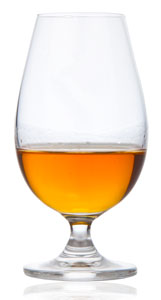Whisky tasting
Whisky tasting is the process of evaluating and enjoying the flavors, aromas, and characteristics of whisky, a distilled alcoholic beverage made from fermented grain mash. Various grains (which may be malted) are used for different varieties, including barley, corn, rye, and wheat. Whisky tasting is both an art and a science, enjoyed by enthusiasts and professionals alike. It involves several steps to fully appreciate the whisky's complexity.
History[edit | edit source]
The history of whisky dates back several centuries, with its origins often debated among Scotland and Ireland. Over time, whisky production spread worldwide, leading to a diverse range of styles and flavors. The practice of whisky tasting has evolved alongside the drink's production, becoming a sophisticated activity that emphasizes the sensory experience of whisky consumption.
Types of Whisky[edit | edit source]
There are several types of whisky, each with its unique characteristics and production methods. These include:
- Scotch whisky, known for its regulations that require distillation in Scotland and aging in oak barrels for at least three years.
- Irish whiskey, typically triple distilled for a smoother finish.
- American whiskey, which includes Bourbon whiskey, characterized by its significant corn content and aging in new charred oak barrels, and Rye whiskey, known for its spicy flavor profile.
- Canadian whisky, often referred to as "rye whisky" in Canada, even if it does not contain a high proportion of rye grain.
Tasting Process[edit | edit source]
The whisky tasting process involves several steps to fully appreciate the spirit's depth:
- Appearance: Observing the whisky's color, which can give clues about its age and the type of casks used for aging.
- Nosing: Smelling the whisky to identify different aromas. This step is crucial as a significant portion of taste is actually determined by smell.
- Tasting: Sipping the whisky and letting it coat the tongue, identifying the primary flavors.
- Finish: Noting the aftertaste or the lingering flavors after swallowing.
During the tasting, enthusiasts often use a tasting wheel to help identify and describe the whisky's complex flavors and aromas, ranging from fruity and floral to peaty and smoky.
Glassware[edit | edit source]
The choice of glassware can significantly affect the whisky tasting experience. A tulip-shaped glass, such as the Glencairn, is widely recommended because its shape concentrates the aromas towards the top of the glass, enhancing the nosing phase of the tasting.
Tasting Events[edit | edit source]
Whisky tastings can be informal gatherings among friends or more structured events led by whisky experts. These events often feature a selection of whiskies, allowing participants to compare different styles and production methods. Tasting events can also include food pairings, where dishes are chosen to complement or contrast the flavors of the whisky.
Whisky Clubs and Societies[edit | edit source]
Numerous whisky clubs and societies exist around the world, bringing together enthusiasts to share their passion for whisky. These organizations often host tastings, educational seminars, and distillery tours, providing members with opportunities to deepen their understanding and appreciation of whisky.
Conclusion[edit | edit source]
Whisky tasting is a rewarding activity that offers insight into the rich world of whisky. It allows individuals to explore the diverse flavors and stories behind each bottle. Whether enjoyed alone or with others, whisky tasting is a journey of discovery, one sip at a time.
Search WikiMD
Ad.Tired of being Overweight? Try W8MD's physician weight loss program.
Semaglutide (Ozempic / Wegovy and Tirzepatide (Mounjaro / Zepbound) available.
Advertise on WikiMD
|
WikiMD's Wellness Encyclopedia |
| Let Food Be Thy Medicine Medicine Thy Food - Hippocrates |
Translate this page: - East Asian
中文,
日本,
한국어,
South Asian
हिन्दी,
தமிழ்,
తెలుగు,
Urdu,
ಕನ್ನಡ,
Southeast Asian
Indonesian,
Vietnamese,
Thai,
မြန်မာဘာသာ,
বাংলা
European
español,
Deutsch,
français,
Greek,
português do Brasil,
polski,
română,
русский,
Nederlands,
norsk,
svenska,
suomi,
Italian
Middle Eastern & African
عربى,
Turkish,
Persian,
Hebrew,
Afrikaans,
isiZulu,
Kiswahili,
Other
Bulgarian,
Hungarian,
Czech,
Swedish,
മലയാളം,
मराठी,
ਪੰਜਾਬੀ,
ગુજરાતી,
Portuguese,
Ukrainian
Medical Disclaimer: WikiMD is not a substitute for professional medical advice. The information on WikiMD is provided as an information resource only, may be incorrect, outdated or misleading, and is not to be used or relied on for any diagnostic or treatment purposes. Please consult your health care provider before making any healthcare decisions or for guidance about a specific medical condition. WikiMD expressly disclaims responsibility, and shall have no liability, for any damages, loss, injury, or liability whatsoever suffered as a result of your reliance on the information contained in this site. By visiting this site you agree to the foregoing terms and conditions, which may from time to time be changed or supplemented by WikiMD. If you do not agree to the foregoing terms and conditions, you should not enter or use this site. See full disclaimer.
Credits:Most images are courtesy of Wikimedia commons, and templates, categories Wikipedia, licensed under CC BY SA or similar.
Contributors: Prab R. Tumpati, MD

